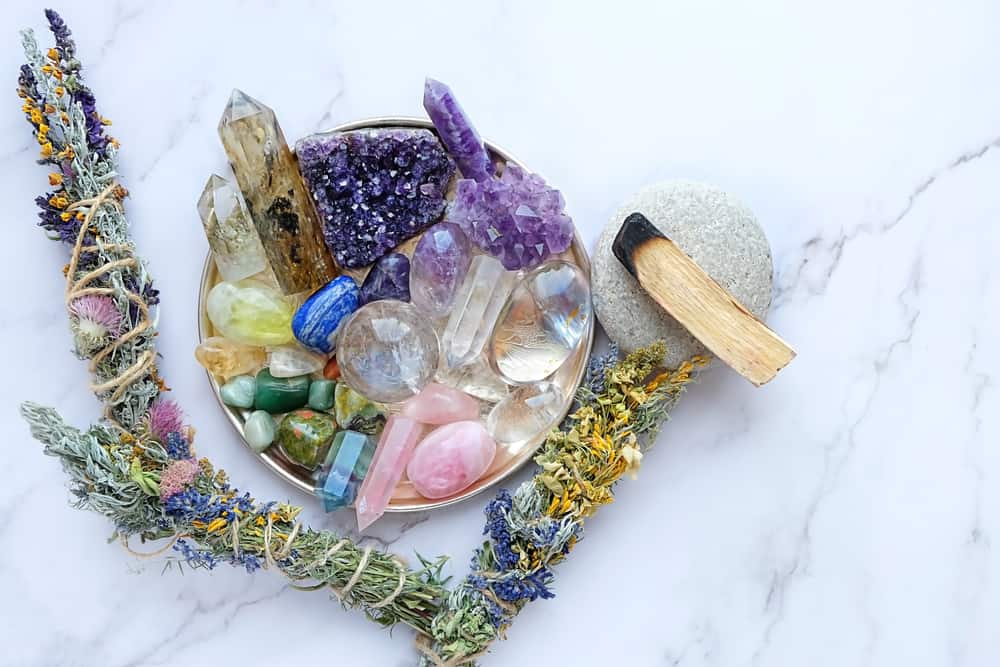You may have seen posts on social media about meditating with crystals. You may even know that crystals can be a powerful tool in your meditation practice, but how do you begin?
Let’s explore why crystal meditation has recently become so popular, and all the benefits—both aesthetic and spiritual—of using crystals to boost and enhance meditation.

Why Meditating with Crystals is Popular
First of all, there is little study or evidence in western culture about the effectiveness of using crystals in meditation. That said, people in many different cultures have used crystals as powerful tools for healing, wellness, and in meditation practice for many years.
Some people believe that crystals have the power to heal, boost mood, and bring about a sense of connection to the earth and surroundings. Thousands of years ago, the Ancient Sumerians used crystals in their magic and healing rituals.
Ancient Egyptians used many different jewels and gems, including crystals, within their rituals and lifestyles. They believed that specific stones brought about protection, health, and wellness. They included stones and crystals in many of the burial rituals.
In the East, stones were used in many different ways. In Chinese culture, jade was revered and used for luck, protection, and healing. In many religions like Jainism, Hinduism, Buddhism, and Islam, stones were included in many practices and rituals. Meditation originated in India and was practiced throughout the East in different forms. Meditation practices often included crystals and precious stones to add beauty, increase luck, and remind users of their ancestry.
Crystals and stones were used in ancient Greece, where the word crystal originated as “krystallos,” meaning ice. They believed that crystals came from water that had been frozen into a permanent form. Greek soldiers and sailors used gems and crystals to keep themselves safe in battle and at sea.
Later in Renaissance Europe, crystals, stones, and gems were used for healing and as protection in battle. Some believed that certain gems could ward off evil spirits. During the Age of Enlightenment, people moved away from the idea that inanimate objects possessed certain qualities or abilities, and people stopped using crystals and gems in religious practices. They still assigned symbolic meaning to gems, however, and they were used by royalty to represent status and wealth.
Gemstones have been used by Native Americans for many years, as well. Tribal cultures use certain stones in their spiritual practices. For example, turquoise is highly sacred to many Native American tribes. Aboriginal and Māori tribes also use stones in their healing and other practices.
In the modern age, crystals and gemstones have come back into popularity in western culture, particularly in meditation practice. Many new-age spirituality practitioners believe crystals have certain vibrations and qualities that can aid in protection, focus, health, wellness, and more. Some people report experiencing certain feelings and even physical reactions when working with different crystals and gemstones.
How Crystals & Meditation Can Affect Our Mood and Consciousness
Because there’s very little scientific study done on the use of crystals, it’s hard to say if they really work to enhance our moods or meditation practice. Many users assume it’s a positive “placebo effect” that aids in focus and self-soothing.
Crystals have a tactile appeal—they are often in interesting shapes. They can feel cool and smooth to the touch. They connect us to the earth and the history of the stone. When we use crystals in meditation practice, we may think about the formation of crystals over time, how long they’ve been part of the planet, and the natural world.
Meditation is a powerful tool for calming our emotions, helping us slow down and center ourselves, collecting our thoughts, and processing different energies. While there haven’t been many studies on crystals, there have been many studies that show that meditation has many benefits. Meditation helps us reduce our stress levels. It can aid with mental health concerns like anxiety and depression. It’s also found to be an effective tool for managing some of the issues connected with chronic pain, high blood pressure, and even heart disease.
Meditation and mindfulness practices are great for wellness, especially when combined with a healthy diet, exercise, and other positive lifestyle choices. If you have issues with anxiety and stress, I also suggest trying a product like RestEZ™ Relaxation Herbal Supplement from Melaleuca. I find their products to be extremely reliable and effective for many issues.
Using a focus tool like crystals to enhance your meditation practice can also be a good idea, especially if you’re new to meditation or have a tough time feeling focused. Guided meditation apps, meditation videos on YouTube, and other free books and resources are also helpful in introducing you to the various types of meditation.
Choose a crystal that feels right to you if you want to use crystals in your meditation practice. You can find crystals at new age shops, gem stores, and of course, online on sites like Etsy. It can be helpful to select a crystal in person, so you can choose based on the feelings you get from it.
Some people who are very spiritually in-tune report that they feel a vibration from certain crystals. They may even see colors, experience tastes, or hear a humming noise when they handle certain stones. Don’t feel bad if you don’t experience this, especially if you’re new to working with crystals. Instead, just pick the stone that you feel drawn to.
Preparing to Meditate with Crystals
If you’ve found a crystal that you’d like to incorporate into your meditation practice, it’s helpful to do some preparation first. Many people like to “charge” or cleanse their crystals before using them. People feel that this resets their energy and helps release any negative vibes the crystals might carry.
You can use salt water or pass the crystal over a candle or incense (particularly sage) to cleanse crystals. Some people like to chant or pray over their crystals or even bury them for a short time. To charge crystals, lay them out in moonlight or the sun, depending on what feels best to you. Keep in mind that some crystals are more delicate, so always research the cleansing method before carrying it out.
Once your crystal is cleansed, you can use it within your meditation session. Some people like to set an intention or focus on the crystal. Others create certain rituals when they meditate, including putting the crystal in a certain spot, chanting over the crystal, or holding it in their hand. They may include it with other meditation rituals like the use of “singing” bowls, prayer beads, or lighting candles.
Rituals themselves can be helpful mental health tools. Scientists have connected the power of ritual with positive sports psychology as well as grieving rituals and practices in many different cultures. When humans connect with a ritual, they often experience a boosted mood and improved confidence. This can help them perform better, heal, and return to a state of mental health.
Once you’ve performed the ritual that feels right to you, you’re ready to carry out your crystal meditation practice. You may want to hold the crystal or put it near you. If you’re working with several crystals, try arranging them in a geometric pattern or “crystal circle” in front of you. Some people like to meditate in a bathtub with the crystal or even place them on their bodies’ chakras. Focus on your breath and allow yourself to relax, slowly entering a meditative state. Close your eyes, take deep breaths, and clear your thoughts. You may notice certain sensations or vibrations coming from the crystals in your mediation practice.
Most practitioners recommend only working with meditation crystals for a short time and only about once per week. If you’re new to crystals, you may want slowly incorporate crystals into your meditation sessions—5-10 minutes at first. If you feel uncomfortable at any time, pause the practice and move around. Hydrate and do some deep breathing.
Store your crystals somewhere safe until the next time you use them. For example, you may want to place them on an altar or store them carefully in a box. Some people like to keep them with certain herbs or other sacred items.
Choosing Different Types of Meditation Crystals
So, what are the different types of crystals, and what are specific crystals known for? There are many different crystals to choose from; many work differently depending on your personal preference, alignment, and vibration.
Here are some common crystals people use in their meditation practice. Be sure to choose the right crystals that appeal to you. Realize that your experience with a particular crystal may differ from other people’s crystal meditation experience.
Amethysts: the purple amethyst is a favorite for many practitioners. Amethysts are often found inside geodes, and they can be a beautiful crystal to decorate your home, as well as to work with in your meditation practice. Amethysts help with bringing a sense of calm and tranquility. They are good for sleep and can alleviate migraines. Amethysts are said to have potent healing properties, and they help with balancing chakras.
Black Tourmaline: This beautiful black stone is protective and helps guard against negative energy. It’s thought to absorb toxicity and vibrations that can come from electronic use. It’s grounding and calming—the perfect stone to help when you’re feeling overwhelmed and frustrated.
Citrine: Citrine is a yellow quartz crystal. It’s considered joyful and positive. It’s also useful for people who are trying to move through an emotional or mental barrier. Citrine helps energy flow and improves mental wellbeing.
Garnet: Red garnet is a beautiful crystal that is believed to be extremely healing and rejuvenating. It’s a good crystal for use in recovery from an accident or illness and can help the body feel refreshed and renewed.
Jade: Beautiful green jade is used in Eastern cultures for luck, abundance, and wealth. It brings about a sense of prosperity and helps attract positive results. People often wear jade in the form of jewelry and incorporate it into home décor as well.
Lapis Lazuli: This gorgeous deep blue stone looks like the night sky. It’s often used in jewelry. It helps increase your intuition. It’s believed that lapis lazuli helps with communication and creativity. In addition, it can be a useful stone for resolving conflicts—internal and external and overcoming stagnation.
Quartz: is typically the standard crystal that most people begin working with. It is available in several forms, but usually, it’s the clear crystal that most people are familiar with. Many believe quartz is the easiest crystal for beginners, as it reduces stress. Smoky quartz and rose quartz are two other popular choices. Smoky quartz is grounding and mood-elevating. Rose quartz is believed to bring on romance, feelings of peace, and love.
Selenite: The gypsum mineral selenite is a bit more delicate than other crystals. It can dissolve in water, so it’s essential not to use water when cleansing your selenite. It looks similar to quartz but has a layered look and a wand-like shape. Selenite can help clear out negative energy and remove obstacles in your path. It is believed to cleanse auras and increase your energy levels. It’s especially useful in meditation.
There are plenty of other stones and crystals out there to help you deepen your meditation practice and connect with the natural world. If you’re looking for an interesting way to increase your focus and positive vibrations, meditation with crystals is a great practice to start.








Leave A Reply!